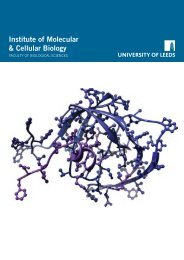Selecting reagents for multicolor flow cytometry with BD™ LSR II ...
Selecting reagents for multicolor flow cytometry with BD™ LSR II ...
Selecting reagents for multicolor flow cytometry with BD™ LSR II ...
You also want an ePaper? Increase the reach of your titles
YUMPU automatically turns print PDFs into web optimized ePapers that Google loves.
application notes<br />
Cell Biology<br />
advertising feature<br />
<strong>Selecting</strong> <strong>reagents</strong> <strong>for</strong> <strong>multicolor</strong> <strong>flow</strong> <strong>cytometry</strong> <strong>with</strong><br />
BD <strong>LSR</strong> <strong>II</strong> and BD FACSCanto systems<br />
©2008 Nature Publishing Group http://www.nature.com/naturemethods<br />
Flow cytometers, such as the BD <strong>LSR</strong> <strong>II</strong> and BD FACSCanto systems, which detect six, eight and more<br />
colors, have spurred the development of new fluorochromes and antibody conjugates to take advantage of<br />
these capabilities. However, choosing optimal antibody-fluorochrome combinations is a complex process.<br />
Here we provide some simple guidelines <strong>for</strong> the selection of reagent panels <strong>for</strong> <strong>multicolor</strong> <strong>flow</strong> <strong>cytometry</strong>.<br />
Reagent selection starts <strong>with</strong> the instrument configuration. The lasers<br />
and detectors dictate whether a given fluorochrome can be excited and<br />
whether there are enough detectors to properly detect a given combination<br />
of fluorochromes. The optical system design also affects the<br />
efficiency <strong>with</strong> which particular dyes are detected, as do the instrument<br />
settings, including photomultiplier voltages. Finally, the choice of optical<br />
filters greatly influences the effective brightness of one fluorochrome versus<br />
another. Virtually testing filter combinations using a web tool, such as<br />
the viewer at http://bdbiosciences.com/spectra/, may be useful.<br />
Given the variety of instrument configurations, it is impossible to<br />
define the best fluorochrome combinations <strong>for</strong> six, eight or more colors.<br />
However, <strong>for</strong> a particular cytometer, such as the BD <strong>LSR</strong> <strong>II</strong> instrument,<br />
it is possible to rank available dyes according to their brightness. How<br />
is brightness defined? A good functional definition should include the<br />
effects of background. In a particular detector, background is influenced<br />
by signal intensity, autofluorescence, nonspecific staining, electronic<br />
noise and optical background from other fluorochromes (spillover), all<br />
of which can increase the width of a negative population (Fig. 1). A good<br />
normalized functional measure of reagent brightness is the stain index 1 ,<br />
defined as D/W, where D is the difference between positive and negative<br />
populations and W is equal to 2 s.d. of the negative population.<br />
When the same antibody is conjugated to various dyes, their stain<br />
indices can be compared to give an idea of their relative brightness on<br />
a particular instrument. We have done this <strong>for</strong> various fluorochrome<br />
conjugates run on both a BD <strong>LSR</strong> <strong>II</strong> and a BD FACSCanto <strong>II</strong> <strong>flow</strong> cytometer<br />
(Table 1). This leads to the first rule of reagent selection: pick the<br />
brightest fluorochromes. For example, in a four-color panel using fluorescein<br />
isothiocyanate (FITC), phycoerythrin (PE), peridinin chlorophyll<br />
protein (PerCP)-Cy5.5 and allophycocyanin (APC), an obvious choice<br />
<strong>for</strong> a fifth color is PE-Cy7 because it is the brightest fluorochrome not<br />
already in the panel. (Cy is a trademark of Amersham Biosciences<br />
Corp. Cy dyes are subject to proprietary rights of Amersham Biosciences<br />
Corp and Carnegie Mellon University and are made and sold under<br />
license from Amersham Biosciences Corp only <strong>for</strong> research and in vitro<br />
diagnostic use. Any other use requires a commercial sublicense from<br />
Amersham Biosciences Corp, 800 Centennial Avenue, Piscataway, NJ<br />
08855-1327, USA.)<br />
Brightness on its own only goes so far. The more colors to be<br />
resolved, the more spillover between those colors becomes an issue.<br />
Compensation can be used to correct spillover <strong>for</strong> the cell population as<br />
a whole. However, signals of individual cells above or below the mean<br />
will result in data spread, which is higher when spectral overlap introduces<br />
additional noise that compensation cannot correct 1 . Data spread<br />
reduces the resolution sensitivity and, there<strong>for</strong>e, the stain index in a fluorescence<br />
detector that receives spillover from other detector(s). Thus, a<br />
second rule of reagent selection is to minimize spectral overlap when<br />
choosing a reagent combination. This rule can conflict <strong>with</strong> choosing<br />
the brightest fluorochromes. For example, PE-Cy5 has a very bright stain<br />
index but has considerable spillover into the APC detector. The resolution<br />
sensitivity in APC will be reduced compared <strong>with</strong> that achieved<br />
Signal height<br />
W 1<br />
W 2<br />
D<br />
Signal width<br />
Holden Maecker & Joe Trotter<br />
BD Biosciences, 2350 Qume Drive, San Jose, Cali<strong>for</strong>nia 95131, USA. Correspondence<br />
should be addressed to J.T. (joe_trotter@bd.com).<br />
Figure 1 | Stain index. The effective brightness of a reagent depends on<br />
the difference (D) between the positive (red) and the negative (blue, green)<br />
populations and the spread of the negative population (W). The stain index is a<br />
useful metric <strong>for</strong> normalized signal over background.<br />
an6 | December 2008 | nature methods
advertising feature<br />
Cell Biology<br />
application notes<br />
©2008 Nature Publishing Group http://www.nature.com/naturemethods<br />
Table 1 | Average stain indices on BD <strong>LSR</strong> <strong>II</strong> and BD FACSCanto <strong>II</strong><br />
Fluorochrome a<br />
1 PE-Cy5 353<br />
PE 302<br />
2 APC 278<br />
2 Alexa Fluor ® 647 214<br />
PE-Cy7 139<br />
1 PerCP-Cy5.5 107<br />
3 BD Horizon V450 85<br />
3 Pacific Blue 80<br />
4 Alexa Fluor ® 488 73<br />
Alexa Fluor ® 700 61<br />
4 FITC 56<br />
5 APC-Cy7 37<br />
1 PerCP 37<br />
AmCyan 25<br />
5 APC-H7 24<br />
Stain index<br />
Average stain index of each fluorochrome conjugate run on both a BD <strong>LSR</strong> <strong>II</strong> and a BD<br />
FACSCanto <strong>II</strong> <strong>flow</strong> cytometer. All fluorochromes were conjugated to BD monoclonal antibody<br />
RPA-T4. Fluorochromes listed <strong>with</strong> the same superscript number are read in the same detector<br />
and thus would not normally be used in combination.<br />
a Alexa Fluor® and Texas Red® are registered trademarks, and Pacific Blue is a trademark, of Molecular<br />
Probes, Inc. The Alexa Fluor, Pacific Blue, and Texas Red dyes are licensed from Molecular Probes.<br />
using, <strong>for</strong> example, a combination of PerCP-Cy5.5 and APC. One might<br />
wish to sacrifice a certain amount of brightness in one detector to avoid<br />
spillover (and loss of resolution sensitivity) in another.<br />
Taking these two rules into account, we selected sets of fluorochromes<br />
that are reasonable choices <strong>for</strong> experiments requiring six, eight or more<br />
colors (Table 2).<br />
Once the fluorochromes have been defined, antibody specificities<br />
can be matched to particular fluorochromes. Brightness and spillover<br />
remain key issues.<br />
As an example, we will discuss CD62L staining on CD8 + T cells. CD8,<br />
an abundant protein, stains very brightly. CD62L is relatively ‘dim’ (the<br />
protein is not abundant on the cell surface and/or the antibodies are of<br />
low affinity). One might consider using the brightest fluorochrome, PE,<br />
<strong>for</strong> CD62L, while using a dimmer fluorochrome, such as FITC, <strong>for</strong> CD8.<br />
But FITC has considerable spillover into the PE detector, compromising<br />
the resolution sensitivity in PE to the point that the CD62L resolution<br />
might be suboptimal. Possible solutions include using <strong>for</strong> CD8 a fluorochrome<br />
<strong>with</strong> less spectral overlap <strong>with</strong> PE or, <strong>for</strong> CD621, using a fluorochrome<br />
that is still relatively bright but does not overlap <strong>with</strong> FITC.<br />
This example illustrates two additional rules: reserve the brightest fluorochromes<br />
<strong>for</strong> dim antibodies and vice versa, but avoid spillover from<br />
bright cell populations into detectors requiring high sensitivity <strong>for</strong> those<br />
populations.<br />
One final consideration is the potential <strong>for</strong> tandem dye degradation.<br />
APC-Cy7, and to a lesser extent PE-Cy7, can degrade in the presence of<br />
light, fixation and elevated temperatures so that they emit in the parent<br />
dye detector (APC or PE), leading to false positive events 1 . By minimizing<br />
the exposure of samples to these conditions, this problem can be<br />
largely avoided. Additionally, BD Biosciences has developed APC-H7,<br />
which displays enhanced stability under these conditions. Still, <strong>for</strong> some<br />
Table 2 | Choices <strong>for</strong> six-, eight- and ten-color experiments<br />
Six-color Eight-color Ten-color<br />
FITC or Alexa Fluor ® 488 FITC or Alexa Fluor ® 488 FITC or Alexa Fluor ® 488<br />
PE PE PE<br />
PE–Texas Red ® or<br />
PE–Alexa Fluor ® 610<br />
PerCP-Cy5.5 PerCP-Cy5.5 PerCP-Cy5.5<br />
PE-Cy7 PE-Cy7 PE-Cy7<br />
APC or Alexa Fluor ® 647 APC or Alexa Fluor ® 647 APC or Alexa Fluor ® 647<br />
Alexa Fluor ® 680 or 700<br />
APC-Cy7 or APC-H7 APC-Cy7 or APC-H7 APC-Cy7 or APC-H7<br />
AmCyan<br />
AmCyan<br />
BD Horizon V450 BD Horizon V450<br />
applications, there is an additional rule: consider the consequences of<br />
degradation of tandem dyes and whether this will compromise sensitive<br />
readouts in the APC or PE detectors. If so, a different reagent configuration<br />
might be in order.<br />
In testing a <strong>multicolor</strong> reagent cocktail, it is wise to include fidelity and<br />
fluorescence-minus-one controls in the initial testing 2 . Fidelity controls<br />
use an antibody by itself (or <strong>with</strong> minimal additional gating <strong>reagents</strong>) and<br />
compare the results <strong>with</strong> those obtained using the antibody in a complete<br />
cocktail. From this, the effect of additional <strong>reagents</strong> on the readout can be<br />
seen, ensuring that the other <strong>reagents</strong> are not compromising that readout.<br />
Fluorescence-minus-one controls combine all the <strong>reagents</strong> in a given<br />
cocktail except <strong>for</strong> one, to gauge the sensitivity of particular detectors in<br />
the context of the other <strong>reagents</strong>. They can also be used <strong>for</strong> routine gating<br />
of those detectors <strong>for</strong> which other means of setting gates are not possible<br />
or practical. Usually, once a reagent panel has been well validated, it is<br />
not necessary to run all of these controls on a day-to-day basis.<br />
Summary<br />
Here we have outlined rules <strong>for</strong> selecting <strong>reagents</strong> <strong>for</strong> <strong>multicolor</strong> <strong>flow</strong><br />
<strong>cytometry</strong>. These rules need to be balanced to achieve the best possible<br />
results. First, choose the brightest fluorochromes <strong>for</strong> a particular instrument<br />
configuration. Second, choose fluorochromes that minimize the<br />
potential <strong>for</strong> spectral overlap. Third, reserve the brightest fluorochromes<br />
<strong>for</strong> dim antibodies and vice versa. Fourth, avoid spillover from bright cell<br />
populations into detectors requiring high sensitivity <strong>for</strong> those populations.<br />
Finally, take steps to avoid tandem dye degradation, and consider<br />
its impact on results.<br />
For Research Use Only. Not <strong>for</strong> use in diagnostic or therapeutic procedures.<br />
BD <strong>flow</strong> cytometers are class I (1) laser products.<br />
BD, the BD Logo and all other trademarks are property of Becton,<br />
Dickinson and Company.<br />
1. Maecker, H.T., Frey, T., Nomura, L.E. & Trotter, J. <strong>Selecting</strong> fluorochrome<br />
conjugates <strong>for</strong> maximum sensitivity. Cytomety A 62, 169–173 (2004).<br />
2. Baumgarth, N. & Roederer, M. A practical approach to <strong>multicolor</strong> <strong>flow</strong><br />
<strong>cytometry</strong> <strong>for</strong> immunophenotyping. J. Immunol. Methods 243, 77–97 (2000).<br />
This article was submitted to Nature Methods by a commercial organization<br />
and has not been peer reviewed. Nature Methods takes no responsibility <strong>for</strong><br />
the accuracy or otherwise of the in<strong>for</strong>mation provided.<br />
nature methods | December 2008 | an7










